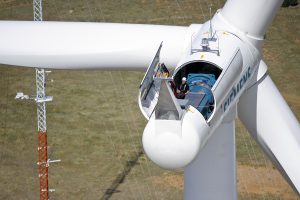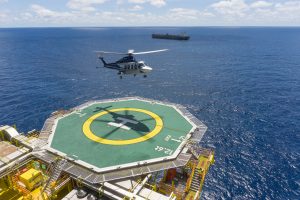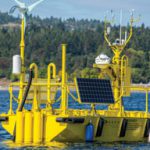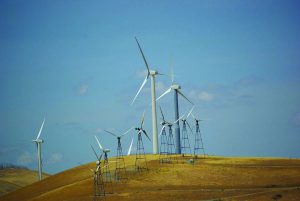Moving an 80-metric-ton transformer
A team with Collett & Sons, a company that transports difficult and abnormal loads worldwide, took on the unique challenge of transporting an 80-metric-ton transformer to the Harting Rig Wind Farm Substation in South Lanarkshire, U.K.
Appointed by Fracht UK, Collett was tasked with providing a transport solution to deliver the massive cargo the 230 miles from Goole to the Harting Rig Wind Farm.
A relatively straightforward journey, Collett left its Goole Heavy Lift facility and slowly made its way to the rural county of South Lanarkshire. However, a mere three miles from the wind farm site, they encountered a challenge, namely Glassford Bridge.

Identified in the planning process, weight restrictions were in place on the structure, resulting in limitations to the vehicles and cargos crossing the bridge. The loaded trailer and truck combination would have exceeded the structure’s maximum permitted weight; therefore, a new approach would be required.
Alongside the weight limitations, Collett was also required to observe a maximum speed of 10 mph and ensure no other traffic or pedestrians would be present on the bridge during the transport operation. In addition, all vehicles must follow a three-meter strip of the bridge, with a series of cat’s eye markers in place to ensure each vehicle maintained a set alignment throughout.
With all this identified, Collett executed innovative transport arrangements to overcome these obstacles. Arriving at Glassford Bridge, the process began, first by uncoupling the loaded trailer from the 8×4 MAN TGX tractor unit. Once disconnected, two 40-meter wire cables were attached, connecting the trailer and primary ballast truck. A secondary 8×4 ballast unit was then connected at the rear of the trailer, again using 40-meter wire cables.
The extended combination was then ready to go. Having implemented temporary traffic restriction orders, the lights on the bridge were turned to red, and Collett was able to proceed. With all other traffic restricted, the secondary ballast tractor reversed, and the primary drove forward. This tensioned the cable, removing any slack, then both vehicles began the slow drive forward. Controlling the cable tensioning throughout, the primary tractor unit cleared the structure, followed by the trailer, transformer, and Steersman in tow. With the ability to control the trailer steering and breaking, Collett’s steersman ensured the trailer and cargo remained within the necessary alignment while traversing the structure. Once clear of the bridge and with the trailer brake applied, the secondary ballast unit took up the cable stack and crossed Glassford Bridge, completing the operation complete.

With the wire cables removed and the primary tractor unit re-coupled, the 80-metric-ton transformer completed the remaining three miles of the journey to Harting Rig Wind Farm. On arrival, the cargo was met by Collett’s Heavy Lift Team for jacking and skidding to its final position.
Spain’s first grid-connected floating wind turbine
Mammoet recently completed the transport and load-out of what will be the first grid-connected floating wind turbine in Spain. The Saitec-manufactured DemoSATH floating unit, or “floater,” is a prototype for energy companies and part of a floating offshore wind pilot project that aims to prove the viability of creating large-scale offshore wind farms in deep waters. The three-hour transport and load-out operation took place in the Port of Bilbao.
Mammoet was asked by Noatum Logistics, Saitec’s subcontractor, to transport and load-out the floater while fitted with a 2-MW wind turbine. Mammoet had collaborated since the beginning on ideas and solutions for the jacking, transport, and load-out of the floater to make sure the transport vessel and supports would stay sufficiently high in the water during the launch.
Once Mammoet identified the best transport path, the floater was transported on SPMTs from its place of manufacture to the quay. Coordination was essential to ensure the availability of the specialist seagoing vessel contractor coincided with appropriate tide levels and weather conditions. The project was carried out during two operations over one tide, so the barge was at the right level to load out the floater and offload the SPMT back onto the quay.

“This type of project is where Mammoet’s experience and heavy lifting and transport capabilities come into their own,” said Mammoet Spain Sales Manager Javier De Pablo Arenzana. “We are well-placed to support the growth of the offshore wind sector in Spain and around the world. As a company, we are committed to sustainable solutions and are proud to be facilitating the energy transition.”
The DemoSATH project leads efforts in Spain’s clean energy transition. Partner energy company, RWE Renewables, hopes to have 1 GW of floating wind capacity in construction or operation by 2030. This technology is needed for a viable alternative to fixed turbines. Floating wind will form part of the Spanish government’s 160 GW of renewable capacity by 2030 with 74 percent renewable electricity generation by that date, rising to 100 percent by 2050.
The project’s success demonstrates how Mammoet’s expertise can support the sector’s expansion. Mammoet previously completed the load-out of five floating wind platforms at the Navantia Fene Shipyard in Spain for Kincardine Offshore Windfarm and worked on other major floating offshore wind projects, including WindFloat and the ELISA project.
More info www.collett.co.uk | www.mammoet.com


































